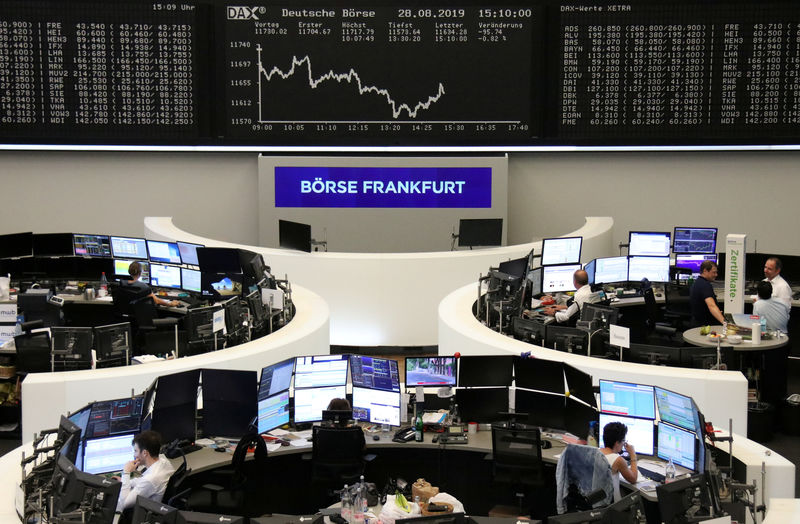By Josephine Mason and Thyagaraju Adinarayan
LONDON (Reuters) - Investors expect central banks will lavish stimulus on markets and spending will help prolong the rally across euro zone stock markets into a second year, according to a Reuters poll, even as worries grow about a recession and damage from Brexit.
According to a survey of nearly 30 brokers, fund managers and analysts taken between Aug. 13-27, the euro zone blue-chip STOXX50 index (STOXX50E) will end the year at 3,400 points, up less than 1% from current levels.
But that would be a 13.3% rise for the year, its biggest annual gain since 2013, and would almost erase last year's heavy losses.
The pan-European STOXX 600 (STOXX) is expected to close the year at 380, just 1.7% higher than Tuesday's close. That would mark a 12.5% rise for the year.
Participants see both indices gaining further ground next year, albeit at a slower pace than this year's double-digit percentage rise.
"Provided we get at least some de-escalation on the trade front, further help from the central banks and, potentially more important, further stimulus for the Chinese economy, we see decent upside for European equities," said Ulrich Stephan, chief investment officer for private and commercial clients at Deutsche Bank (DE:DBKGn).
He has pegged the STOXX50E at 3,370 by the end of this year and 3,530 by the end of 2020.
(GRAPHIC: STOXX50E median - https://fingfx.thomsonreuters.com/gfx/mkt/12/5336/5288/stoxx50.png)
(GRAPHIC: STOXX median - https://fingfx.thomsonreuters.com/gfx/mkt/12/5335/5287/STOXX.png)
Most of the headwinds that have battered European equities and pushed them to a discount against their U.S. counterparts - Brexit, global trade tensions, struggling auto industry and malaise across the banking sector due to negative rates - are priced into stock values, investors say.
That helps explain why the poll results haven't changed much over the course of this year - this is the third quarterly poll in a row that has shown a broad range of forecasts with only modest changes to median estimates.
The stasis in forecasts suggests investors are still struggling to assess the impact of the protracted trade battle between the world's two largest economies and worrying about a slowing economy while companies in the region suffer a corporate recession.
It also underscores the subdued optimism that has driven this year's rally, with investors buying equities in search for returns as bond yields fall into negative territory.
A big driver behind the gains has also been the European Central Bank's dovish about-turn earlier in the year. The ECB is expected to announce a stimulus package at its Sept. 12 policy meeting, making several rate cuts in the coming year and a fresh round of bond purchases, commonly known as quantitative easing.
In what would be a big deal for markets though, investors are also hoping Germany will also make a U-turn from its devotion to balanced budgets and embark on a spending spree to boost Europe's largest economy, rather than just relying on central bank policy.
UNDERPERFORMER
Still, it's not all rosy. Several investors said the euro zone will continue underperforming other developed markets given the potential for a recession and the gains are built on fragile ground.
"Sentiment isn't bearish enough and valuations aren't low enough to compensate for this mix of deteriorating outlook without lower prices," said Lars Kreckel, global equity strategist at Legal & General Investment Management.
"We do not expect it, but a much more-proactive-than-expected ECB is a potential upside risk for European equities."
He pegs the STOXX 600 at 400 by the year-end and the STOXX50E at 3,500.
Paul O'Connor, head of multi-asset at Janus Henderson, advises investors to be ready for more volatility.
"Despite this year's broad-based bounce, the big picture remains one of an ageing bull market in equities.
"While buy-and-hold investing was the right approach when markets were trending strongly higher, the more turbulent market regime that we foresee will demand a greater emphasis on volatility management and dynamic asset allocation," he said.

(GRAPHIC: Europe vs U.S. - https://fingfx.thomsonreuters.com/gfx/mkt/12/5270/5227/US.png)